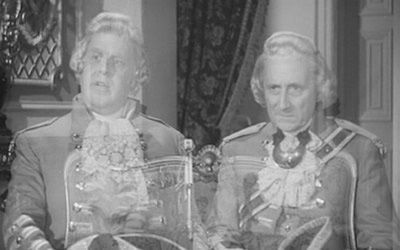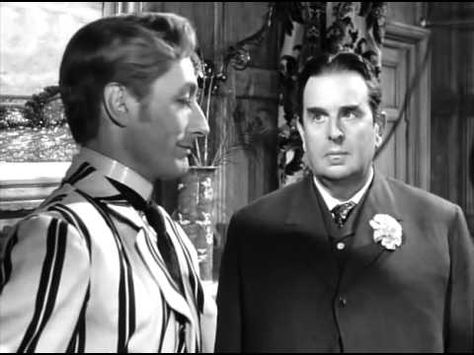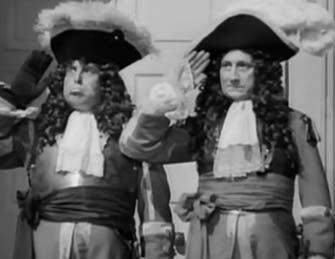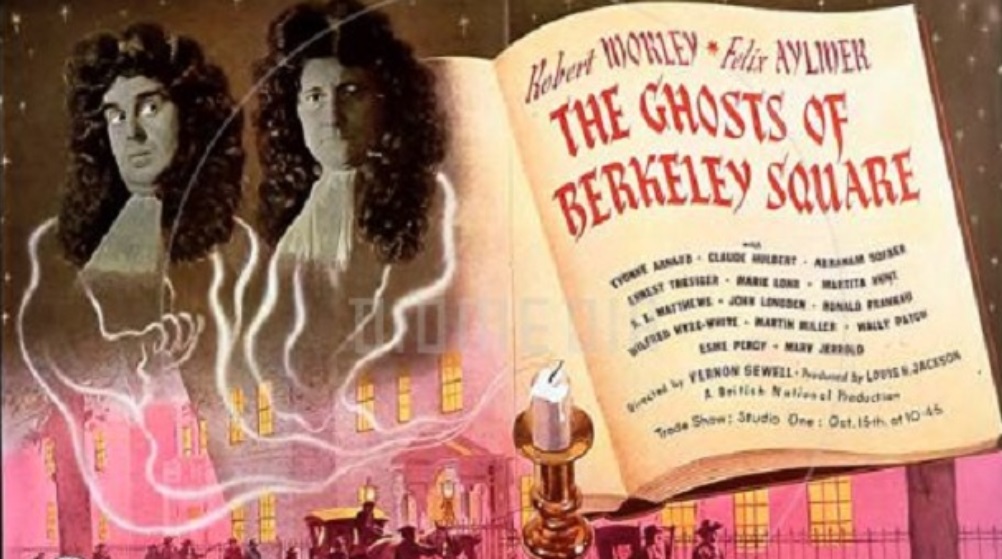Two ghosts wait patiently for eternity.
The last time this site was in Mayfair it was for The Notorious Landlady (1962) and the Londonflat occupied there by one Kim Novak, rumored to be a murderess owing to a missing husband.
Also located in Mayfair is Berkeley Square. Now take some steps back fifteen years in movie years and a few centuries in screen time and it’s The Ghosts of Berkeley Square. In a house on the square live two quite dead ghosts, waiting, waiting for a long-anticipated eternity, anxious, always despairing, never wholly optimistic; waiting for an English monarch—any monarch—to come to their residence and release them to the Great Beyond.
The film is a compilation of the best and worst of British humor . . . er, humour. Within the confines of their parts, the portly Robert Morley and his much more slender companion Felix Aylmer do the best they can—droll, understated, easygoing, their characters reluctant to indulge in anything so undignified as ghost-scaring. Hans May’s score, when it’s not utilizing source music such as Sydney Baynes’ Destiny, James Tate’s Broken Doll and many traditional tunes, is more ghastly than ghostly.
 The film was made in the late 1940s. Considering what, say, Universal had done back in the mid-‘30s, makers of the movie, British National Films, are quite behind the times. The simplest of special effects are pop-on, pop-off images and the standard double exposures for the ghostly appearances. Morley and Aylmer are most often seen as themselves, nontransparent, unaltered.
The film was made in the late 1940s. Considering what, say, Universal had done back in the mid-‘30s, makers of the movie, British National Films, are quite behind the times. The simplest of special effects are pop-on, pop-off images and the standard double exposures for the ghostly appearances. Morley and Aylmer are most often seen as themselves, nontransparent, unaltered.
Except for Martita Hunt, many of the better known supporting players—Ernest Thesiger and Wilfrid Hyde-White—are either unrecognizable beneath powdered wigs or lost in a brief pass-through in the course of the haphazard script.
Largely unnecessary is a brief introduction, the thousandth gathering of the one hundred members of the Old Ghosts Association, those who “either are or have been a ghost in regular practice.” The Morley and Aylmer characters propose to share with their guests a reminiscence of their two hundred years “on active service” as specters.
In this opening scene, the camera, tracking the length of the table over the assembled ghosts, will never again be as mobile in the rest of the film.
 So, to begin the story, it’s 1708 and two officers in Queen Anne’s army, General “Jumbo” Burlap (Morley) and Colonel “Bulldog” Kelsoe (Aylmer), want to prevent a war and plan to kidnap the big proponent of that war, the Duke of Marlborough—the first duke of a new peerage created by the Queen herself. In testing their trap door to the basement where they plan to imprison their victim until war is averted, the two officers are killed and become—well, what else . . . ghosts.
So, to begin the story, it’s 1708 and two officers in Queen Anne’s army, General “Jumbo” Burlap (Morley) and Colonel “Bulldog” Kelsoe (Aylmer), want to prevent a war and plan to kidnap the big proponent of that war, the Duke of Marlborough—the first duke of a new peerage created by the Queen herself. In testing their trap door to the basement where they plan to imprison their victim until war is averted, the two officers are killed and become—well, what else . . . ghosts.
Soon, there is the magical arrival of the document of their court-martial, appearing with a “pop.” They are found AWOL and sentenced to inhabit the house on Berkeley Square until a British monarch crosses its threshold.
Although Lady Mary (Hunt) has royal connections and arrives looking for new lodgings, Queen Anne hates her, so “Jumbo” and “Bulldog” set their ghost-scaring into practice—noises, a stuffed bear, slamming doors, bird prints on the carpet and objects crashing to the floor. After Lady Mary has fled in horror, the two belatedly realize their mistake. Now no will come to the house if they think it’s haunted.
They fall out as to who is to blame and refuse to speak to one another for sixty-six years, communicating through quill and paper, until the arrival of a gift forces them to speak. They decide to open the present together. Inside is a cuckoo clock which announces not the hour but the day and year, as just at that moment: “Christmas Day, 1760.” A fully decorated tree appears (“pop!”) and, outside, carolers sing “Silent Night,” fifty-eight years before it was written. But no matter.
Reconciled, they work to attract a royal visit. Their house, however, is turned into a bordello by Madame Millie (French actress Yvonne Arnaud): “Ghostees! Ghostees, where are you? Come here at once!”
 After she and her girls have been evicted, there arrive various temporary occupants—an Indian rajah and his harem, a P.T. Barnum theatrical group and American Indians. As more years pass and it becomes a hospital for Boer War wounded, “Bulldog” somehow magically develops a new drug (unclear as to how in the script) to cure a fatally ill Captain Dodds (James Hayter). It is a medicine from the future, penicillin, “not to be used until 1943” (actually first used in 1941).
After she and her girls have been evicted, there arrive various temporary occupants—an Indian rajah and his harem, a P.T. Barnum theatrical group and American Indians. As more years pass and it becomes a hospital for Boer War wounded, “Bulldog” somehow magically develops a new drug (unclear as to how in the script) to cure a fatally ill Captain Dodds (James Hayter). It is a medicine from the future, penicillin, “not to be used until 1943” (actually first used in 1941).
With the arrival of World War I, London is besieged by German zeppelins. As the two stand on the balcony of the house, a dirigible breaks through the night clouds. “Silly, really, fighting in a balloon,” “Jumbo” remarks. “They couldn’t possibly hit anything,” “Bulldog” responds casually.
In the next instant the house is destroyed by a bomb and the two sit among the ruins wondering what will become of them. Then there’s an arrival. It’s Queen Mary, come to see the bomb damage! The two ghosts see themselves disappearing and returning to their 1708 clothes. “This is it!” shouts “Bulldog.” “Going up!” the two shout together. And a final glissando on a toy whistle. Poof!
Best to enjoy the film for what it is.
[embedyt] https://www.youtube.com/watch?v=dshYLEfT_Cc[/embedyt]
